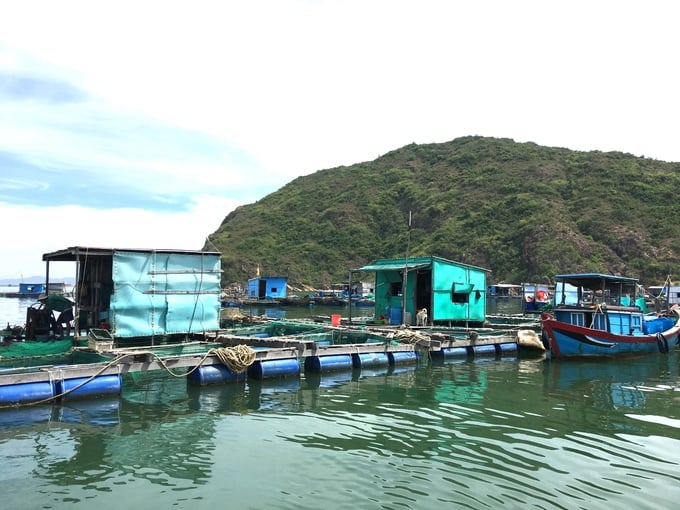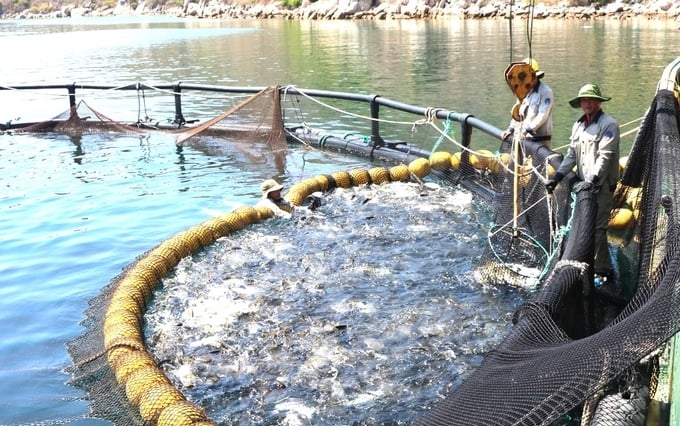November 25, 2025 | 01:45 GMT +7
November 25, 2025 | 01:45 GMT +7
Hotline: 0913.378.918
November 25, 2025 | 01:45 GMT +7
Hotline: 0913.378.918
Associate Professor Dr. Vo Van Nha, Deputy Director of Aquaculture Research Institute 3, said that developing mariculture in an industrial direction means the production scale must be large enough, gradually moving from closed sea areas to open, remote sea areas. This is the orientation that Vietnam's marine aquaculture industry must follow in the next 20 - 30 years.
To convert traditional mariculture to industry, the first thing to do is to increase propaganda so that mariculture people realize that the conversion will bring many benefits. For example, reducing economic losses caused by natural disasters.
"Accessing advanced technology and farming methods will reduce damage caused by diseases and improve economic efficiency. Farmers enjoy the State's support policies on mariculture such as being assigned water surface, issued farming area codes, damage support, and debt extension when risks and unusual incidents occur during the farming process; connected to product consumption through trade promotion channels", Associate Professor Dr. Vo Van Nha emphasized.
Khanh Hoa province has set a clear direction. According to Mr. Nguyen Duy Quang, Director of Khanh Hoa Department of Agriculture and Rural Development, in the upcoming time, for near-shore waters, this province will hand over seawater to the people according to Article 44, Law on Fisheries 2017 so that people can use it. Mariculture can feel secure in investing in production. At the same time, guides mariculture people to convert from traditional wooden cage farming to cages made of new material (HDPE) that can withstand wind and waves, ensure safety and aesthetics, combined with the marine tourism model, raising new varieties with economic value, essential products, combining multi-species farming to increase efficiency and reduce environmental pollution.

The South Central coastal provinces are organizing changes in cage materials and marine farming technology. Photo: V.D.T.
Phu Yen province is reorganizing, including changing materials for making cages and farming technology in lagoons and bays. Simultaneously, breakthrough development of industrial aquaculture in open offshore waters is achieved when all economic and technical conditions and policy mechanisms are met.
“Phu Yen plans to maintain about 1,500 hectares of mariculture in the tidal lagoon and bay areas; lagoon and bay water area of about 1,000 hectares; The open sea area near the shore and along the coast is about 1,650 hectares. Mariculture will become a key product in the seafood sector. Lobster will become a key product, contributing at least US$ 100 million/year to the province's export turnover", said Mr. Nguyen Tri Phuong, Deputy Director of the Department Phu Yen Agriculture and Rural Development.
Binh Dinh has considered organizing vocational training to supplement knowledge and skills for mariculture people to meet the needs of mariculture career development, which focuses on prioritizing training in modern cage technology and farming processes for animals with high economic value.
“We will build mariculture demonstration models using new material cage systems HDPE materials and apply and develop 4.0 technology in mariculture cage management. Organize propaganda and replicate effective models in the mariculture community", shared Mr. Tran Van Phuc, Director of Binh Dinh Department of Agriculture and Rural Development.
In the institutional development of industrial mariculture, we must change our thinking, consider businesses as subjects, and simultaneously develop advanced technology combined with a multi-sectoral integration approach.
According to experts, we must reorganize the marine space to ensure harmony between exploitation and farming, farming and processing, fisheries, and marine tourism development. Marine tourism models and activities must be associated with nature conservation and ecological environment; Sustainable development in parallel with marine economic sectors such as aquaculture, building value chains in a circular economy.

Khanh Hoa is guiding mariculture people to convert from traditional wooden cage farming to cages made of new material (HDPE) that can withstand wind and waves. Photo: V.D.T.
Currently, some types of marine tourism combined with mariculture are an increasingly popular trend, such as experiential tourism, discovering authentic local activities, mariculture facilities, Exchanging training tours, learning new models and technologies in mariculture, aquaculture...
Faced with the advantages that tourism combined with mariculture brings, according to experts, local governments need to establish mariculture industry clusters and simultaneously strengthen propaganda to help mariculture people recognize and implement the necessary work. Converting to industrial methods and scale, helping to increase output and quality of aquaculture products, protecting the marine environment. In addition to combining tourism and mariculture, it is necessary to integrate mariculture with other marine economic sectors such as oil and gas, plastics, wind power, shipping...
Translated by Tuan Huy

(VAN) Green transition is crucial for the Mekong Delta amid climate change and stricter standards, offering a path toward sustainability.

(VAN) Dong Thap promotes agricultural restructuring, forms large specialized farming zones, raises the value of agricultural products and develops toward ecological and high-tech directions.
/2025/11/22/4018-4-213342_747.jpg)
(VAN) The Mekong Delta Agricultural Experts Club has attracted 143 experts and researchers to participate in providing consultancy and contributing initiatives to the development of one million hectares of high-quality rice.

(VAN) Ca Mau’s development of OCOP products opens a path to increasing cooperatives value, helping boost income, expand markets, and affirm collective economy's role.

(VAN) Turning seemingly ordinary coconut shells into unique jewelry and artwork, Nguyen Bang Nhi spreads the value of local culture through her brand, Cocohand.

(VAN) Results from the Sustainable Durian Model Project in Dak Lak have confirmed the critical role of Yara Viet Nam in transferring advanced nutritional solutions to farmers.

(VAN) In Tuyen Quang province, livestock farmers have introduced effective models and innovative practices that significantly strengthen African Swine Fever prevention and control efforts.